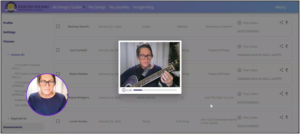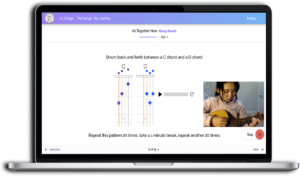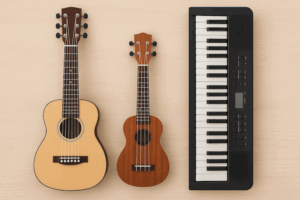What is the earliest age to start giving my kids music lessons? 👦🏼
You can expose your kids to music at anytime (they can even hear in the womb), but learning an instrument requires coordination, strength, and a sufficient attention span. An ability to focus and practice is often the most limiting factor. Here is a rough guide:
- 3 Years Old: Repeat counting to 4 while clapping or patting your legs to build a sense of rhythm
- 4 Years Old: Strumming ukulele or small toy guitar. Playing the 1 finger C chord on uke
- 4 – 6 Years Old: Playing multiple chords on ukulele when their fingers are long and strong enough
- 5 – 6 Years Old: Playing single notes and easy melody on piano
- 5 – 7 Years Old: Playing chord progressions, songs, and singing on the ukulele. Can consistently practice even if just 5 minutes.
- 8 Years Old: Learn beginner guitar or piano. Sufficient coordination and ability to focus and practice for ~15 minutes multiple times a week.
Drums is also an easy instrument to start around 2 years old and progress in skills as they gain coordination.
What kind of Guitar, Ukulele, or Keyboard should I buy? 🎸
For beginners, especially those in elementary and middle school, we recommend starting with a simple, affordable starter instrument that matches your child’s size and interest:
- Guitar: A full-size steel string guitar works well for teens and taller pre-teens (taller than 5′), while younger students (ages 6–11 or under 5’ tall) often benefit from a 3/4 size guitar that’s easier to hold and play. Nylon-string guitars are softer on the fingers and good for young beginners. We offer a variety of sizes and types in our Home School Guitar Kits.
- Ukulele (you’ll want the Soprano style): This is a great first instrument for smaller hands and has a gentle learning curve. It’s light, portable, and inexpensive. Makala Dolphin’s are very popular in elementary school music programs. The Mahalo U30 Soprano is another good option.
- Keyboard: A 61-key digital keyboard is ideal for piano beginners. Look for one with touch-sensitive keys for better dynamic control.
Need guidance on what to buy? Email [email protected] with questions.
What do I need to get started with guitar? 🎤
Just a few extras can make a big difference:
- Tuner (clip-on or app): You should tune every time before you play to keep the instrument sounding right. If you need help tuning, book a tuning consultation with one of our pros.
- Capo: Used when students get to the advanced beginner stage to help them play songs i the artist’s key.
- Lesson practice platform access: With Moosiko, we include access to all our guided online lessons, song tutorials, and learning tools.
- Optional accessories: Guitar picks, strap, a set of extra strings, and case (soft or hard) for transport are helpful.
If you’re purchasing through our Homeschool Guitar Kits, everything your child needs is already included and covered by EFA funds.
What should I expect as a homeschool parent? Anything I can do? 👩🏻
You don’t need to be a musician yourself — we’ve designed our program to be self-guided and student-friendly. But here’s how you can support your child:
- Establish a routine: Set aside 15–30 minutes a day, 4–5 times a week. It really does take consistent practicing.
- Create a dedicated space like a bedroom, basement, or corner of the living room: Quiet, distraction-free, and comfortable.
- Encourage, don’t pressure: Progress looks different for everyone. Celebrate small wins — the first chord, first progression, the first song, the first performance!
- Check in: Ask what they’re learning and listen when they want to show you something.
Most of our students learn their first song in the 3 – 6 weeks based on current skill level and amount of practice. You can also sit in on a lesson or learn alongside your child. We have discounts for family members.
How much should I expect to pay to get started with music lessons? 💵
Prices range based on type of instrument, lesson type, and lesson frequency. Here are some general rules of thumb. View our Homeschool Music Kit pricing here (EFA and ClassWallet approved).
- Guitars: Quality beginner guitars can be found for $80 used to $300 new. We recommend buying a new guitar in the $180 – $300 price range. Cheaper guitars tend to fall out of tune more easily which frustrates students, inhibits learning, and break more easily.
- Ukuleles: Beginner soprano ukes can be found for $50 – $150.
- Keyboards: $75 – $100 for bare bones 61-key keyboard. We recommend a slightly higher quality $150 – $300 that includes touch sensitivity.
- Online Lessons: $200/year for self-paced lessons, $500/year for weekly group lessons, and $1,500/year for weekly 1:1 private lessons.
- In-Person Lessons: $1,300/year for weekly group lessons and $3,900 for weekly 1:1 private lessons.
- Music Apps: There are a variety of apps out there for $20/month. These are nice as supplemental tools but shouldn’t be the sole source of instruction. At least for the first year, a music teacher (online or in-person) is critical to set goals, help students get unstuck, and provide motivation.
How many hours a week will my child need to practice? How long until they are good? 📈
We recommend:
- 15–30 minutes per session, shorter is ok at the beginning when their fingers are getting used to pressing down the strings
- 4–5 days a week
Consistency is key. In the first month, your child will learn how to tune, play clean sounding chords, and start to learn the transitions of chord progressions. Many songs only have 3 or 4 chords and we start with those first.
“Good” is a moving target — some students progress quickly, others take a little longer. Most homeschool students reach a comfortable playing level (5–10 songs, multiple chords, strumming patterns) in 3–6 months. At the end of our homeschool online guitar lessons, students will have learned most of the common chords, will be able to play thousands of songs, and have some basic music theory to build upon. If they are interested, we help students sing while playing and even write their own songs.
Here is an example of a typical 2 month progress from a 10 year old.
How do online lessons actually work? 🧑🏾🏫
We make online learning simple and engaging:

- Skill Survey: Students complete a skill survey so we know their starting point and music goals. We create a personalized lesson plan for them.
- Step-by-Step Song Lessons: Students are given access to our learning platform with 400 songs from the 1950s to today. They pick a song they like and are guided with simple step-by-steps lessons. We track skills and allow teachers to provide video feedback right in the platform.
- Music Teacher: All students are assigned a certified music teacher to set goals, track progress, and motivate students. If you sign up for one of our live lesson plans (group or 1:1 private), you’ll have weekly video calls with your teacher to ask questions, practice with other students, and get new assignments from your teacher.
You can learn a lot more on our website here: moosiko.com/homeschool-guitar-lessons

Step-by-step instruction makes learning easy and fun
What will my child learn? Songs? Skills? Theory? 🎶
We teach everything in the context of real music. Our primary goal is to get students playing the instrument with songs they love. While we’re not specifically focusing on music theory, they will learn a lot of it in real-time. Here is what every student will learn at the end of our program:
- Basic Guitar or Uke Skills: Chords, transitions, progressions, strumming patterns, tuning, flat picking, melodies / riffs, scales, and rhythm.
- Playing Songs: From classic rock to folk to pop — kids stay motivated by playing music they know. They will be able to play full songs consistently. Those that like to sing will learn how to sing and play at at the same time.
- Theory: Major and minor chord charts, scales, basic note reading (staff and TAB), playing with others, improvisation (i.e. soloing)
Whether your child wants to play around a campfire, lead worship, write their own music, or just play for joy — they’ll get the foundation they need.


